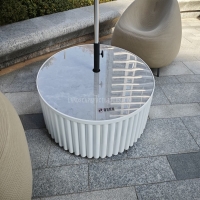Welcome to the website for landscape facilities products and knowledge.
How does the table integrate with other furniture in a cohesive landscape or interior design scheme?
A table is rarely an island in the landscape of a room. Its integration into a cohesive interior or exterior design scheme is a deliberate act of harmony, balancing aesthetic appeal with functional purpose. Achieving this synergy requires a thoughtful approach to several core design principles.
The first consideration is scale and proportion. A table must relate not only to the human form but also to the surrounding furniture. An oversized dining table can dwarf adjacent chairs and a sideboard, creating a sense of bulk and imbalance. Conversely, a diminutive coffee table lost in a vast living area fails to anchor the seating arrangement. The goal is visual equilibrium, where each piece feels like a natural companion to the others, creating a comfortable and inviting spatial relationship.
Beyond size, style and form establish the visual dialogue between pieces. A sleek, glass-and-chrome table naturally converses with modern, minimalist sofas and shelving, speaking a common language of clean lines and reflective surfaces. A rustic, reclaimed wood table, however, finds its kin in linen upholstery, wrought iron accents, and organic textures. This doesn't mandate a matching set; in fact, contrast can be powerful. A robust, traditional wooden table can be strikingly grounded when paired with delicate, modern chairs, but the connection must be intentional, often through a shared material, color tone, or subtle design motif.
Materiality and color form the tangible threads that weave furniture together. Repeating a material—such as the oak grain of a table appearing in the legs of a chair or the frame of a cabinet—creates a powerful, unifying rhythm. Color palettes act similarly. A table’s finish, whether stained, painted, or natural, should either complement or thoughtfully contrast with the dominant hues in the space. A pop of color on a console table can be picked up in throw pillows or artwork, visually stitching the area together. Texture adds the final layer of depth, with smooth, rough, glossy, and matte surfaces interacting to create a rich, tactile experience.
Finally, function dictates form. The table’s role is paramount. A console table in an entryway must work in concert with a mirror and perhaps a bench, forming a functional vignette. A bedside table’s height and surface area are dictated by the bed frame and the need for accessible storage or lighting. In landscape design, a sturdy outdoor dining table integrates with comfortable seating, shade solutions like a pergola, and the surrounding greenery to create a unified outdoor room.
Ultimately, a table ceases to be a solitary object when it is thoughtfully scaled, stylistically resonant, materially connected, and functionally aligned with its companions. It is through this careful integration that a collection of individual furniture pieces transforms into a singular, harmonious, and beautifully composed design scheme.
Related search:

Recommendation
Round metal tube border design table with tempered glass or granite countertop on the top.